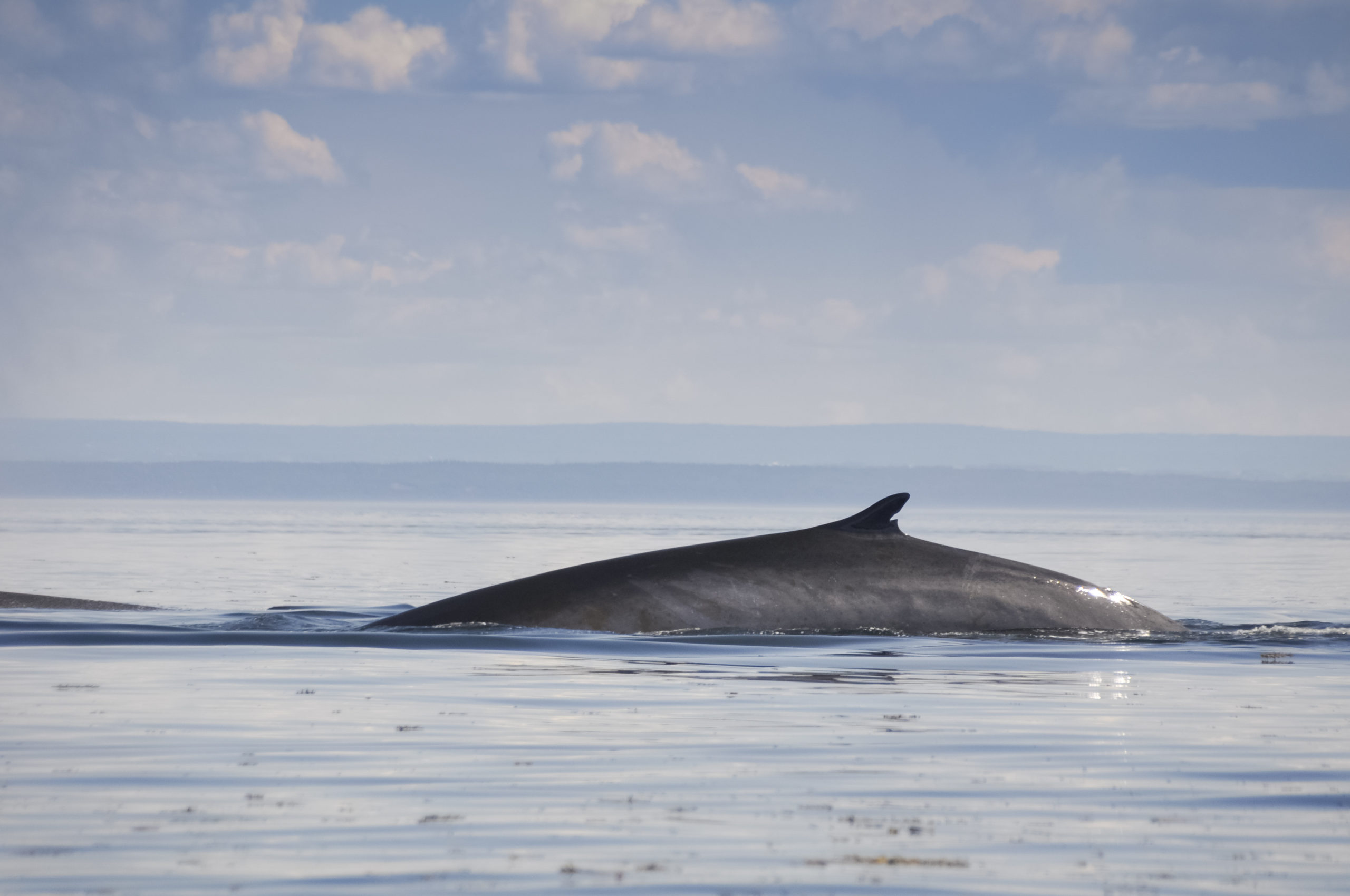The fin whale is the second largest animal on earth, after the blue whale. It gets its name from a distinctive fin about two thirds of the way on its back. Fin whales have streamlined, sleek bodies with a pointed head (rostrum).
They belong to the baleen whale family group and specifically the rorqual sub-type, which also includes blue whales, humpback whales, sei whales and minke whales.
Fin whales have very unique colouring – they are dark grey on the back and light on the underside. Both the belly and the underside of the flippers are almost white. Even the colouring on its head is highly asymmetric – its left side is dark grey and the lower parts of the right side are bright white.
Many fin whales have ‘chevrons’ which are light grey in colour and start just behind the blowhole, continuing along the back of the body in the shape of broad V’s.
And speaking of blowholes – the fin whale produces a tall columnar blow that can be up to six metres high. A telltale sign to spot them in the water.
The species is called the ‘greyhound of the sea’ for good reason. Fin whales can cruise at up to 15 kilometres per hour and can accelerate in short bursts of speed of up to 28 kilometres per hour.
Their lifespan is 80-100 years old and average weight is 40-80 tonnes.
On the shy side
Fin whales are generally solitary or found in pairs. They’re rarely be found in large groups. The species tends to stay out of the limelight. They rarely breach or spyhop and they avoid raising their fluke out of the water for much of the time.
In the early days of whaling, the fin whale’s speed in the water made it a difficult target for hunters. But as boats got faster and hunting tools evolved, that advantage disappeared.
The species was relentlessly hunted for its oil, meat and baleen with hundred of thousands of animals believed to have been slaughtered. Sadly, the fin whale is still hunted in some parts of the world today.
The global population is estimated to be between 50,000 and 90,000. It’s difficult to put a firm figure on it as they spend so much time out in ocean waters and are less likely to be spotted. The fin whale is listed as an endangered or vulnerable species in several regions.

Where do they live?
Fin whales are usually found out in the open ocean as opposed to coastal waters. Like other large whales, fin whales’ behaviour sees them migrating between feeding and breeding grounds. Their seasonal movements are less predictable and understood than other baleen whales. There’s still a lot to be learnt about how this species lives.
You can find resident fin whale populations in some part of the world, including the Gulf of California in Mexico, the East China Sea (off Japan) and the Mediterranean Sea.
Fin whales prefer cooler waters so you won’t find them popping up in tropical waters any time soon! The largest population is thought to be in the North East Atlantic with an estimated 25,000 – 30,000 fin whales living there.
Cooler offshore waters where they are spotted around the world include the waters around Argentina, Ireland, Canada, Norway, Spain, Greenland, Iceland, Brazil, Denmark, Chile, Peru, Ecuador, the U.S., Morocco and many more.
What do they eat?
Like other baleen whales, fin whales have expandable pleats which allow them to take in huge amounts of water and food.
They spend several hours each day feeding and are lunge feeders, which means they roll on their sides with gaping mouths open to take in the food.
Then they sieve the water out through their baleen plates before they ingest their tasty catch. Fin whales consume up to two tonnes of krill in a day, along with small fish and crustaceans.
Threats to fin whales
Ship strikes
Whale hunting was once the biggest threat to fin whales but the most pervasive threat now is ship strikes. This is especially true in the Mediterranean Sea. An annual study of seasonal feeding aggregation of fin whales off the Catalan coast (Spain) has taken place since 2014.
Its finding is that ship strikes represent the greatest conservation threat for fin whales in the Mediterranean Sea with at least four fin whales found dead in Barcelona Port since 1986 due to ship strikes. Seven live whales have been documented with injuries in the study area since 2018.
Noise
Fin whales are one of the loudest animals in the ocean with a frequency sound of up to 196.9dB. When there is competing underwater noise from vessels, it can negatively affect fin whale populations who will change their normal behaviour and move away from important breeding or feeding areas.
It is also possible that prolonged exposure to noise can increase the chances of a fin whale becoming disorientated and/or stranding.
Environmental change
This can lead to both loss of habitat (as waters become warmer) and lack of food for fin whales. Plastics and micro plastics in the ocean pose a threat to whales, along with all other marine mammals and fish. As do chemical pollutants entering into the water ecosystem.
Changing water temperature and currents can impact the timing of important environmental cues for whales such as when it is time to depart to feed or to migrate to breed.
Entanglement
Like other whales, fin whales can become entangled in fishing gear. They can either become anchored and die or swim off with the gear (which usually results in fatigue, compromised feeding ability or severe injury and ultimately can lead to death).
Natural predators
The only known natural predator of fin whales is the orca but due to the fin whale’s large adult size, it’s usually calves who are targeted for predation.



